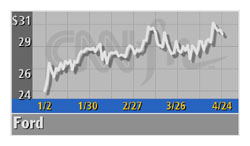|
Ford faulted for tire failures
|
 |
April 25, 2001: 11:07 a.m. ET
Consumer groups blame automaker for poor design of Firestone tires
|
WASHINGTON (CNN) - A report by two consumer groups concludes that the defects found in Bridgestone/Firestone tires -- the subject of a nationwide recall last year -- can be blamed on the tires' poor design, which was engineered by Ford Motor Co.
According to the report by Public Citizen and Safetyforum.com, both Firestone and Ford (F: Research, Estimates) are to blame for the tires' problems, but it concludes "the real problem begins and ends with Ford Motor Co."
The National Highway Transportation Safety Administration (NHTSA) attributes at least 174 deaths and more than 700 injuries to accidents involving the defective tires. Most of those accidents occurred when the tires' tread separated, causing a blowout.
The reports fault Ford because the automaker made the key decisions on specifications for the tires, recommending a lower tire pressure on Ford Explorers and ignoring rollover stability problems. The tires were used mainly on Explorers.
 Public Citizen and Safetyforum.com said they wrote the report after analyzing all data pertaining to the tires and the accidents they were involved in that has been filed with the government, as well as evidence provided in lawsuits. Public Citizen and Safetyforum.com said they wrote the report after analyzing all data pertaining to the tires and the accidents they were involved in that has been filed with the government, as well as evidence provided in lawsuits.
The report says the poor design of the tires is not limited to the 14.4 million involved in the recall last year, and conclude that all 15-inch Wilderness AT tires and all 16-inch Wilderness AT tires -- regardless of where they were manufactured -- should be recalled. These tires, the report says, may actually be more prone to tire separation than the ones involved in the voluntary recall.
Many of the tires found to have problems during the recall came from one manufacturing plant in Decatur, Ill.
The report says it is Ford's duty to inform customers of potential dangers associated with the tires. It suggests that an owner notification program should include: information and specifications for cargo weight limits, full disclosure that increasing the tire pressure may increase the risk for vehicle rollover, a description of the difficulty of controlling the vehicle if tread separation occurs, an explanation that although the vehicle meets government standards for roof structure, there may be an increased risk of "roof crush" if the vehicle rolls over, and there is no special safety device that provides additional protection in that event.
Ford spokesman Ken Zino said the company was aware the groups' report was coming out, but had not reviewed its findings.
[Click here for auto stocks]
"We continue to cooperate with NHTSA and hope groups with information provide it directly to NHTSA," he said.
The report also makes recommendations on how NHTSA should act to protect the public. One suggestion is that the agency update the current tire safety standard, which is now 30 years old.
This action is currently under way as part of the Transportation Recall Enhancement and Documentation Act (TREAD), which passed last November. The final rule is expected by June 2002.

[Click here for CNNfn's Special Report: Firestone Ford Recall]
The report also recommends the creation of a "real world" test and standard for roof crush. The current law tests for a static load, while the report contends a new standard should take into account roll-over situations. In doing so, the report says, the agency also should set a dynamic rollover standard. Rollover crashes are blamed for at least one-third of vehicle occupant fatalities.
NHTSA is also being asked to require special occupant protection, possibly with different kinds of seat belts, to prevent ejection in rollover crashes.
NHTSA currently is working on the report's final recommendation, which calls for manufacturers to notify the government as soon as it is apparent there is a potential defect in one of their products.
The groups also are calling on the government to conclude the investigation before summer, saying a recall is needed before the hot weather sets in. According to the Safetyforum.com litigation data base, almost half the crashes involving Firestone tires occurred during the months of June, July and August.
Ford filed an analysis of the Firestone defect with NHTSA earlier this month. In its report, the company concurred with Firestone that faulty tire design and manufacturing is the root cause of the problem. However, Ford also blamed poor customer tire maintenance. The automaker maintains that the Ford Explorer is not to blame for the incidents involving Firestone tires. 
|
|
|
|
|
 |

|

